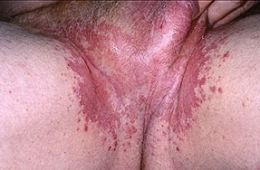Candida in the intertriginous areas (skin folds) is a very common problem that I encounter on a daily basis amongst my patients in both the Woodlands dermatology and Conroe dermatology offices. The skin folds are subject to intense friction, which can macerate the skin resulting in a denuded surface that allows the yeast to flourish along with the sweat and humidity found in these areas. A Candidal rash can be differentiated from a dermatophyte (ring worm) as Candida produces a beefy red moist rash with satellite pustules unlike the more dry scalier rash of a dermatophyte. In addition to drying these areas, using an oral and topical -azole type of antifungal is usually necessary. A one time dose of oral fluconazole is usually sufficient in addition to topical clotrimazole (Lotrimin) or ketoconazole cream (Nizoral) used twice a day until the rash resolves. Unlike dermatophytes, Candida can be an invasive and serious infection that can enter the blood stream resulting in a fatal septicemia if left untreated especially in immunocompromised patients.
September 27, 2010




